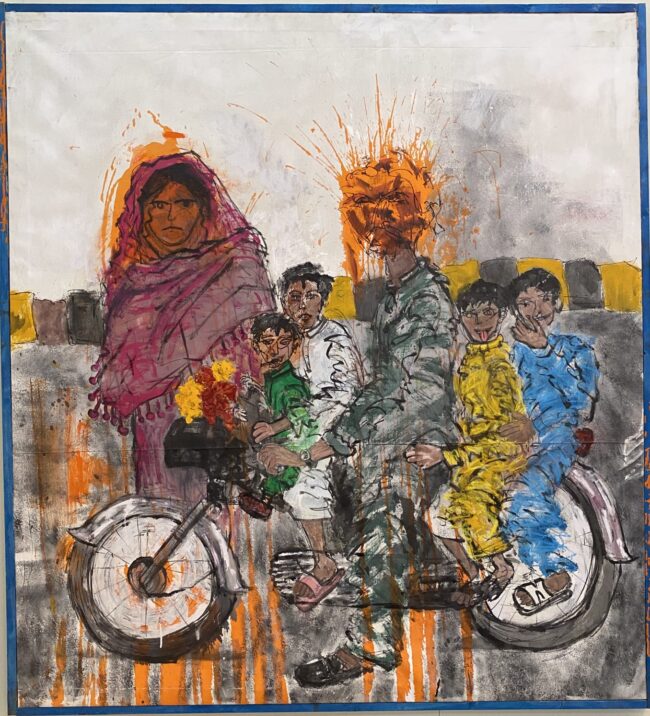Young and ambitious Ali Murtaza, currently residing in Italy, has a multifaceted artistic journey that reflects late capitalism in his art practice
Young and ambitious Ali Murtaza, currently residing in Italy, has a multifaceted artistic journey that reflects late capitalism in his art practice
Ali Murtaza, born in 2000, is a Pakistani-origin multidisciplinary visual artist currently residing in Italy. His expansive practice spans paintings, multimedia, installations, performances, and photography, embodying a profound exploration of identity and the absurdities of modern life. As he pursues his MFA degree, Murtaza continues to develop his studio practice and exhibit internationally, including a notable upcoming exhibition at the Anima Mundi Art Fair in Venice. His artist statement reveals an underlying commitment to examining human evolution, capitalism, and the dilemmas of contemporary existence through bold, symbolic art.
Murtaza’s journey as an artist began in Pakistan, where he developed a deep interest in visual art from a young age. His early experiences in a country rich in cultural and historical significance profoundly shaped his artistic sensibilities. Murtaza’s education at a prestigious art school in Pakistan laid the foundation for his diverse practice, allowing him to experiment with various mediums and forms. His early work, exhibited in major Pakistani cities like Karachi, Lahore, and Islamabad, quickly gained recognition for its innovative approach and critical engagement with societal issues.

Murtaza’s multidisciplinary approach reflects a dynamic blend of influences and inspirations. His art draws heavily from everyday life, incorporating elements from advertisements, billboards, cartoons, and comics. This fusion of high and low culture creates a distinctive visual language that is ubiquitous and constitutes the lived environment.
In his artist statement, Murtaza describes his process as intuitive, often trusting his instincts to guide the creation of his bold symbolic visuals. This intuitive approach allows him to capture the complexities and absurdities of societal mechanisms, power dynamics, and social structures. His art serves as a mirror, reflecting the often overlooked but significant aspects of daily life that influence individual and collective identities.
Central to Murtaza’s work is the exploration of identity and its transformation within the context of late capitalist societies. This thematic focus serves as a compelling entry point into a broader discussion of capitalism, late capitalism, and postmodernism, particularly through the lenses provided by theorists such as Frederic Jameson and Niklas Luhmann. These scholars provide critical insights into how contemporary economic systems and cultural frameworks impact individual and collective identities.
To understand Murtaza’s exploration, we must first contextualize the term capitalism. Capitalism, characterized by private ownership of the means of production and the creation of goods or services for profit, has profoundly shaped societies since the Industrial Revolution. It emphasizes market-based economies, competitive individualism, and consumerism, which collectively influence societal norms and individual identities.

The concept of late capitalism, as popularized by Frederic Jameson, delves into the evolved state of capitalism marked by globalization, technological advancements, and an omnipresent market ideology. Jameson describes late capitalism as a period where cultural production is heavily commodified, and economic rationality permeates every aspect of life. This phase is characterized by the intensification of corporate power, financialization, and the erosion of traditional social structures, leading to significant implications for identity.
In late capitalist societies, identity becomes increasingly commodified. Individuals often define themselves through their consumption patterns and the brands they associate with. The saturation of media and advertising further compounds this, creating a hyperreal environment where images and symbols take precedence over tangible reality. Jameson suggests that in this context, personal and collective identities become fragmented and superficial, mirroring the ephemeral nature of market trends.
Postmodernism, a cultural and intellectual movement associated with the latter half of the 20th century, intersects with the period of late capitalism. It is characterized by skepticism toward grand narratives and ideologies, embracing instead relativism, pluralism, and the deconstruction of traditional boundaries. Postmodernism questions the very foundations of identity, suggesting that it is not a stable essence but rather a fluid and dynamic construct.
Jameson sees postmodernism as the cultural logic of late capitalism. In his seminal work, “Postmodernism, or, The Cultural Logic of Late Capitalism,” he argues that the postmodern condition reflects the commodification of culture and the pervasive influence of multinational capitalism. The postmodern era, according to Jameson, is marked by pastiche, depthlessness, and a waning of affect, all of which profoundly impact the construction of identity.

Niklas Luhmann, a German sociologist, offers another perspective on the interplay between society and identity through his systems theory. Luhmann views society as a complex system composed of various subsystems (e.g., economy, politics, law) that operate based on distinct codes and communications. In late capitalist societies, these subsystems become increasingly differentiated and autonomous, complicating the process of identity formation.
According to Luhmann, individuals navigate these multiple subsystems, each imposing different roles, expectations, and forms of communication. Identity, therefore, becomes a multi-faceted construct that must adapt to various contexts and subsystems. This multiplicity reflects the fragmented nature of postmodern identity described by Jameson but emphasizes the structural aspects of societal organization.
Murtaza’s work, situated within the context of late capitalist societies, explores how these economic and cultural conditions reshape identities. For instance, in a globalized economy, identities are often influenced by transnational flows of goods, people, and ideas. This can lead to hybrid identities that incorporate diverse cultural elements, challenging traditional notions of homogeneity and authenticity.
Furthermore, the digital revolution, a hallmark of late capitalism, has transformed how identities are constructed and perceived. Social media platforms, driven by capitalist imperatives of data monetization and advertising, encourage users to curate and perform their identities in highly visible ways. This performative aspect aligns with Jameson’s notion of the superficiality of postmodern culture, where image and representation dominate.
Murtaza also addresses the impact of economic precariousness on identity. In late capitalist societies, where job security and social safety nets are increasingly undermined, individuals often experience heightened anxiety and instability. This economic vulnerability can lead to a sense of dislocation and fragmentation in personal identity, echoing the broader cultural condition of postmodernism.
Murtaza’s work often features mundane everyday situations presented comically and exaggeratedly. This approach not only engages viewers but also challenges them to question established norms and re-evaluate their positions within the broader societal framework. By highlighting the contradictions and absurdities inherent in modern life, Murtaza engages in critical reflection and meaningful conversations about power and influence. The hidden mechanisms of power that shape societal structures and influence individual identities are brought to the surface in Murtaza’s recognizable appropriation of artistic styles. His use of comical and satirical visuals serves as a powerful tool for critiquing these power dynamics.
In his exploration of identity, Murtaza often addresses the concept of the “identity crisis” that many individuals face in contemporary society. A sense of disconnection and fragmentation characterizes this crisis, as traditional notions of identity are increasingly challenged by globalization, technology, and capitalism. His participation at the Anima Mundi Art Fair in Venice represents a significant milestone in his career. He is selected to exhibit his works at the “Consciousness” exhibition, which coincides with the Venice Biennale 2024. Murtaza has the opportunity to reach an international audience and further establish his presence in the global art scene. This exhibition promises to be a pivotal moment in Murtaza’s career, allowing him to showcase his work on one of the world’s most prestigious art stages. As Murtaza continues to evolve as an artist, his commitment to exploring and critiquing the absurdities of contemporary life remains at the core of his practice.

COMMENTS